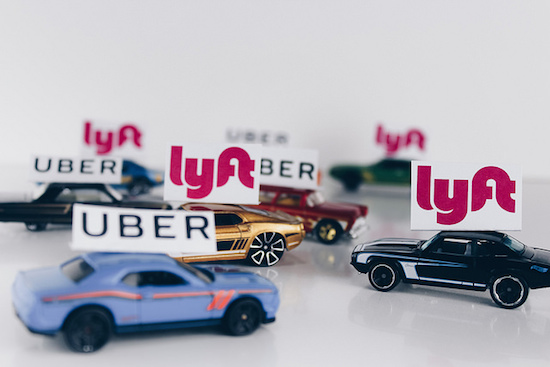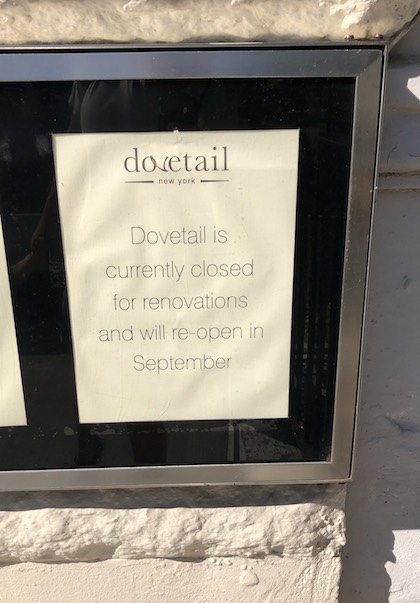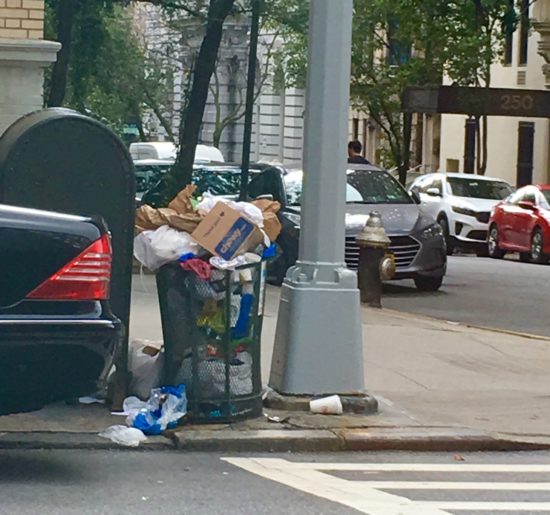
Photo courtesy of quotecatalog.com.
By Carol Tannenhauser
The number of app-based, for-hire cars licensed in New York City has more than quadrupled in the past three years to 63,000. Last Wednesday, the City Council voted to freeze that number for one year, mandating the Taxi and Limousine Commission (TLC) to study the impacts of the explosive growth of Uber, Lyft and Via on both drivers and the city, to determine if and how the industry should be regulated going forward.
Local Council Member Mark Levine (District 7), who voted for the legislation, explained in a telephone interview why he felt it was so important.
“One of the effects of the dramatic increase in licenses is that we have more and more drivers competing for fares, and, therefore, longer and longer wait times for the drivers between passengers,” he said. “It’s estimated that 40% of the time of the average driver is spent cruising around with no passengers. That affects their income, obviously; they’re not being paid for that time, even though they’re burning gas. So many of the vehicles you see crowding the streets of midtown and the Upper West Side don’t have passengers. They’re not performing a function and they’re costing us in terms of congestion and the environment.”
Levine stressed that “they’ll be a pause for a year, but there will be no reduction in vehicles. And we’re going to allow additional licenses for wheelchair-accessible vehicles, so there will be growth in that category, which is very important.
“As of now,” he said, “only about 400 app-based, for-hire vehicles are wheelchair accessible, out of 63,000.”
Council Member Helen Rosenthal (District 6), a co-sponsor, praised the legislation.
“Ensuring every driver in New York City earns a decent wage, tackling the nuances of congestion, and properly regulating app-based vehicles is a fair, evidence-based, and comprehensive approach,” she wrote in an email to WSR. “Even better, the 12-month moratorium on new licenses exempts wheelchair-accessible vehicles – a powerful incentive to finally start adding accessible vehicles to the road. It also stresses that if an area of the city is under-served by for-hire vehicles, the TLC is authorized to issue new licenses.”
The mayor has already announced that he will sign the bill into law. It will take effect 120 days after signing. Vehicles in the process of applying will be grandfathered in.









The reasons Uber, Lyft and Via are so successful is because they provide a good service at a reasonable price.
I use Uber a lot for work when I travel and it’s much cheaper than a taxi.
I’m not sure what Levine is hoping to accomplish by penalizing these companies.
I’m curious if he’s getting some kind of contribution from the taxi industry.
I use Dial 7 all the time. You should try it. The cars are very clean and comfortable and the drivers are extremely helpful. I’ve been in Uber a couple of times and the cars were tiny and the drivers surly. Never again.
There will still be PLENTY of for-hire cars available. As the article says, there are so many drivers that many are driving around with no passengers and that’s no good for anyone. They are not cutting down on the number of drivers we currently have (and actually incentivizing much needed wheel chair accessible cars). I believe this regulation will go a long way!
in response to Sherman:
apparently you’re not familiar with the most basic economic concepts, such as “market failure” and “externalities.”
the market failure is that the drivers are being pushed into penury.
the externalities caused by Uber and Lyft — which they don’t pay for — are increased congestion and increased pollution.
In response to Bruce E Bernstein:
The market failure here is caused by the rent-seeking caused by the medallion system. The drivers being driven into penury were trying to participate by purchasing medallions whose value were inflated due to artificial supply limits. Uber et al disrupted the status quo by meeting demand and bursting the bubble.
I think about this whenever I’m trying to hail a cab during rush hour and wondering why there aren’t more cabs. Then I pull out my phone and order a Lyft (I hate Uber on principle)
I feel bad for the medallion owners who suffered the collapse in the value of their medallions. IMO the city should somehow forgive their debts, similar to how the Federal government helped people out of underwater mortgages during the mortgage crisis. It’s not fair economically to bail out the losers, but it’s morally fair (IMO) to bail out good people who didn’t understand the larger economic forces at play.
I think the powers that be should look more carefully at Via. Their business model is brilliant. At its core is ride sharing which is good for congestion and the environment. Their drivers are paid hourly whether their cars are full or not. This also incentivizes them to drive slowly and safely since they’re not looking to maximize rides.
“Ensuring every driver in New York City earns a decent wage..”
And yet, they didn’t do a thing about raising wages for taxi drivers and livery drivers at non-app based services (i.e. Dial 7, Carmel).
Why is that? Seems like it was targeted to make certain businesses more expensive to operate.
Let’s be honest here… the city councilors were doing this at the behest of the taxi medallion owners. Their ‘concerns’ make zero sense otherwise.
Personally, I choose to support the taxi drivers in this city for a variety of reasons, the gist of which is contained in the link below.
https://www.nytimes.com/2017/09/10/nyregion/new-york-taxi-medallions-uber.html
I do not feel bad at all for the Uber, Lyft, Via drivers who are not making money. Supply and demand is doing its job – if they can’t make money doing this job, find another job.
I do feel bad for the cab drivers, who under a different set of rules paid a lot of money for the opportunity to do this job, and their fares are regulated. They can’t easily walk away from it.
The delivery trucks double parked on both sides of Columbus and Amsterdam that turn three lanes into one are a whole lot worse for traffic than unoccupied ubers. Focus on that instead of trying to fix the only reliable source of transportation in Manhattan
Agreed. Banning parking on avenues would significantly reduce congestion and it wouldn’t cost the city a dime. We as a neighborhood need to stop being afraid of the free parking lobby that loudly opposes any improvement to our streets.
The number of 104 buses running on Broadway has diminished and the route is no longer all the way to the UN. Also the number 5 bus no longer going the length of Manhattan, requiring transfer in midtown. Still I waited an hour on 23St and 6 Ave, for a number 7, which still runs up to UWS.
If there were more buses, there would be less need for hail a ride.
Good point. Especially relevant to voters who are stair-avoidant.
“I’m not sure what Levine is hoping to accomplish by penalizing these companies.” – Sherman
did you skip this?
“Local Council Member Mark Levine (District 7), who voted for the legislation, explained in a telephone interview why he felt it was so important.
“One of the effects of the dramatic increase in licenses is that we have more and more drivers competing for fares, and, therefore, longer and longer wait times for the drivers between passengers,” he said. “It’s estimated that 40% of the time of the average driver is spent cruising around with no passengers. That affects their income, obviously; they’re not being paid for that time, even though they’re burning gas. So many of the vehicles you see crowding the streets of midtown and the Upper West Side don’t have passengers. They’re not performing a function and they’re costing us in terms of congestion and the environment.”
You can tell that the council members know that this bill will hurt anyone who uses a for hire vehicle. The best Helen Rosenthal can muster is that it will help encourage wheelchair accessible vehicles. That’s an important goal for our city, but why not pass a bill that does that directly? She’s concerned about congestion but had refused to come out in supoort of confession pricing! Mark Levine is concerned that 40% of the time these vehicles don’t have a passenger, with absolutely no reference for that number. Is it higher or lower than taxis that have to cruise around looking for someone standing on the street? Not to mention the green cans which are prohibited to pick up passengers in Manhattan, essentially agueanteeing that they will spend half of every trip into the busiest part of the city empty. What percentage of the time is the average personal car in Manhattan crowding the streets without a passenger (if it’s parked on a Manhattan street it’s waaaaay lower than 40%). Uber is almost certainly more efficient than competing modes of transportation, which means capping Uber will make useless congestion worse off. If their defense is “nothing will change, it’s just a cap”, then why pass a bill that doesn’t do anything? It’s such a transparent lie.
Taxi medallion owners (many of them multi millionaires and shady to boot, like Trump’s lawyer Michael Cohen) are upset that Uber is offering a better service and eating into their business. Their response has been “if you can’t beat ‘em, ban ‘em.” I don’t know why our council members have gone along with the medallion owners plan, maybe they think Uber is a big mean tech company and hurting them is a victory for Mom and Pop?
Exactly. The councilors are propping up medallion owners at the expense of the drivers and consumers.
You’ll notice that many of these medallion owners also donate generously to the mayor and the city council.
the existing Uber and Lyft drivers supported this measure, as did the yellow cab drivers.
the business model of Uber is to get as cars on the street as possible, which obviously drives down the earnings of existing drivers.
i support people earning a fair day’s wage for a fair day’s work.
6 taxi and livery drivers have committed suicide because of financial destruction. these are hardworking men and women.
Bruce – I support a living wage for drivers too. The way to achieve that is to pass a law guaranteeing them a living wage, not this Rube Goldberg style policy of banning new competition, hoping that leads to higher prices, and hoping that Uber then decides to share that with drivers (and does anyone really think they will?)
We guarantee a living wage for restaurant workers by mandating a minimum wage, not banning new restaurants.
Hi Josh P.,
From an economic perspective, you make a valid point.
However, i don’t believe the City of New York can set a minimum wage. That depends on the state.
there were other reasons to limit the number of cars, the prime one being the negative “externalities” created by Uber and Lyft. these are pollution and congestion.
however, i agree that the touchstone issue here was the pay of the drivers. the yellow cab and Uber/Lyft drivers are united that in limiting the number of Uber/Lyft cars on the street, the pay of the drivers will go up.
there were other living wage provisions in the legislation, but i think they are very complex.
What they should’ve done was instead of having private businesses and ride-sharing services pay for the governments total incompetence when it comes to the MTA, they should’ve first revamped the system, top to bottom. Bus lanes should be standard on every bus line (M10, maybe, maybe not, but every other line needs one.) All door boarding, paying before you board. Every line should have the quality of the +Selectbusservice options, but 3x the speed. Instead of phasing out MetroCards on the subways, do it on the buses first. On the Subways, modernize the signals, make the proper renovations and repairs. All buses should run 24/7, not the trains. 5am-11pm should be a good runtime for the subways. Tokyo has 5 million more people in its city limits, and it does exactly that and has a 99% on-time rate. During those off hours, have shuttle buses mirror EVERY SINGLE ROUTE, running in tandem with the buses.
The West Side should have more than just the BxM2 running. Split some of the routes, or add more to the west side. Brooklyn, Queens and Staten Island express buses should run into the Upper West and Upper East Side. People shouldn’t have to travel through Manhattan if they want to get from Brooklyn to the Bronx, or from Queens to Brooklyn. The Subways can go deeper into Queens, the Southeast Corner of the Bronx should have subway or Metro-North access. The 1 train should just go all the way up to 263rd street, plain and simple. The 242nd Street station is just too random of a terminal. All out-of-city buses should have at least a little overlap.
If you get the MTA’s on-time performance to at least a B (85%), and ridership still doesn’t budge, then find the problem, make more improvements and expansions, and THEN you should cap Uber.
Capping Uber and Lyft and Via now was by far the wrong move to make, even with their “Good intentions”
Cab drivers will often refuse to take me places that are inconvenient to them, such as the airport or to an outer boroughs. The cab industry and black car business is so corrupt in this city, it’s good to see companies like Uber, Lyft and Via come along and provide better service and clean cars at a fair price.
Maybe we need to get rid of legacy yellow taxis and black cars from NYC and move to a more modern, less corrupt, and less discriminatory model. Let the free market work. Don’t limit our transportation options.
Also, fix the subways so we don’t have to be so car dependent in this city to get somewhere on-time!
I won’t get into the Uber/Lyft vs cab debate. Sometimes I do take Lyft for longer rides, because it can be cheaper if there is traffic. But generally I support cab drivers and they do a better job. Although if you want A/C, there’s no guarantee in a cab, still often third-world in that area for some reason. But my main gripe is doing this to Via, which is offering a completely alternative service to these three, as rideshare-only, constantly carpooling people back and forth across the city. This is the only affordable way I can get to work and avoid the subway, from upper Upper West Side to Midtown. This is a radically different, cheaper service, which is using vehicles to maximum efficiency. In fact, there are usually longer wait times for these vehicles. To lump them readily into the same for-hire category shows the council has not done any homework prior to this legislation.